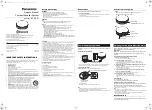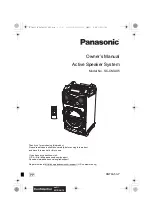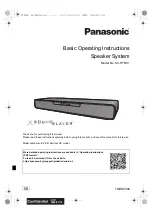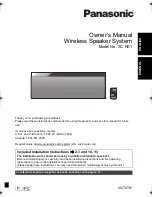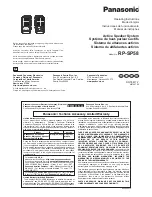
CVK8K - 6000 Series Range
5
Controlli
Controls
SW1 Regolazione Volume nota dichiamata (3 Livelli)
SW1 Call tone volume control (3 levels)
PT1 Regolazione Luminosità
PT1 Brightness control
PT2 Regolazione Colore
PT2
PT2 Hue control
PT3 Regolazione Contrasto
PT3
PT3 Contrast control
Impostazioni (Dip-Switch)
Settings (Dip-Switches)
L’impostazione del videocitofono viene eseguita tramite i 2 banchi dip-switch.
The videophone setup is carried out by the 2 dip-switch banks.
DIP-SWITCH a 8 VIE (SW1)
8 WAY DIP-SWITCH (SW1)
Switch 1 Indirizzo d’Appartamento
OFF 1
ON 2
Switch 1 Apartment Address
OFF 1
ON 2
Switch 2,3 Indirizzo Interno
OFF OFF 1
ON OFF 2
OFF ON 3
ON ON 4
Switches 2,3 Extension Address
OFF OFF 1
ON OFF 2
OFF ON 3
ON ON 4
Switch 4 Intercomunicazione
OFF tra i videocitofoni dei due appartamenti
ON tra i videocitofoni dello stesso appartamento
Switch 4 Intercommunication
OFF Between videophones of the two apartment
ON Between videophones in the same apartment
Switch 5,6 Numero di squilli
OFF OFF 2
ON OFF 4
OFF ON 6
ON ON 8
Switches 5,6 Number of Rings
OFF OFF 2
ON OFF 4
OFF ON 6
ON ON 8
Switch 7,8 Durata Privacy
OFF OFF 15 minuti
ON OFF 1 ora
OFF ON 4 ore
ON ON 8 ore
Switches 7,8 Privacy duration time
OFF OFF 15 minutes
ON OFF 1 hours
OFF ON 4 hours
ON ON 8 hours
DIP-SWITCH a 2 VIE (SW2)
2 WAY DIP-SWITCH (SW2)
Il dip-switch a 2 vie serve per adattare l’impedenza del segnale
video. L’impostazione di default è “ON” per entrambi gli switch (75
Ohm): in presenza di più videocitofoni collegati in parallelo (senza
distributore video), gli switch devono rimanere entrambi ad “ON”
solo per l’ultimo (in ordine di connessione) videocitofono, mentre
per tutti gli altri devono essere impostati entrambi ad “OFF”.
The two way dip-switch adjusts the impedance of the video signal. The de-
fault setting is “ON” for both switches (75 Ohm): when there are more vide-
ophones in parallel connection (without video distributor) both switches must
be “ON” only on the last videophone (looking at the connection order) while
for all other videophones both switches must be set to “OFF”.
Segnali sulla morsettiera
Signals on connection terminals
Ingresso/Uscita 20Vdc (come ingresso 16÷20Vdc 0,5A – come uscita 20Vdc
0,5A max)
+V
20Vdc Input/Output (As input 16÷20Vdc 0,5A – as output 20Vdc 0,5A max)
Riferimento di massa per il moV
_
Ground reference for +V terminal.
Uscita fonia proveniente dal microfono della cornetta e segnale dati (12V
circa in stand-by, 5V circa in conversazione)
1
Speech line output from handset’s microphone and data signal (Approx. 12V
in stand-by, 5V during a conversation)
Ingresso fonia verso l’altoparlante della cornetta (12V circa in stand-by, 3V
circa in conversazione)
2
Speech line input toward the handset’s loudspeaker (Approx. 12V in stand-
by, 3V during a conversation)
Segnale video bilanciato 1 sinc.-
V1
Balanced video signal 1 sync.-
Segnale video bilanciato 2 sinc.+
V2
Balanced video signal 2 sync.+
Ingresso d’alimentazione 24Vac 1A max
24Vac
24Vac 1A max power input
Ingresso d’alimentazione 0Vac
0Vac
0Vac power input
Ingresso per chiamata locale (5V stand by, 0V in funzione)
LB
Local call input (5V in standby, 0V to trigger)
Uscita pulsante di servizio di tipo attivo basso abilitata dalla pressione del
pulsante (Open collector 24Vdc 100mA max)
SB
Service button (open collector) active low output. SB goes low when the
button is pressed (Open Collector 24Vdc 100mA max)
Ingresso 12Vdc per LED di segnalazione porta aperta
LD
12Vdc input for door-open LED
Ingresso fonia verso l’altoparlante del citofono collegato in parallelo (12V
circa in stand-by e 3V circa in conversazione)
2A
Speech line input toward the loudspeaker of the parallel telephone (Approx.
12V in stand-by, 3V during a conversation)
Uscita commutata riferimento di massa citofono in parallelo
3A
Switched ground for parallel telephone
Uscita tono di chiamata per citofono in parallelo
4A
Output call tone for parallel telephone
Ingresso comando apri-porta citofono in parallelo
5A
Input for door-open command from parallel telephone





















